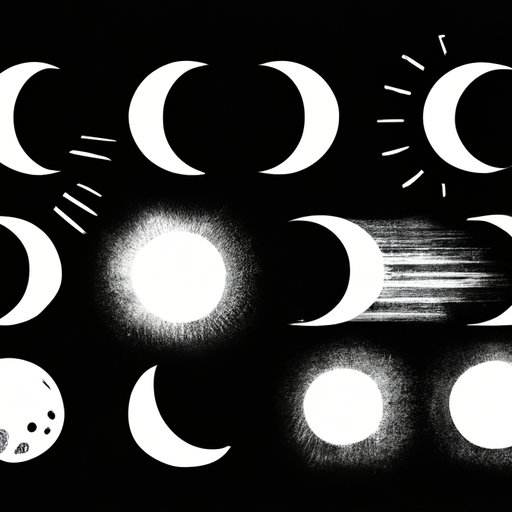Introduction
The moon has been a constant presence in human history, inspiring art, literature, and scientific inquiry for centuries. The lunar cycle—the phases of the moon as it orbits around Earth—is one of the most fascinating celestial phenomena. In this article, we’ll explore the science behind the moon’s phases and its cultural and philosophical significance.
The Science Behind the Moon’s Phases: Exploring the Lunar Cycle
So why do we see the moon in different phases? It all comes down to the interaction between the sun, the moon, and Earth. The moon doesn’t produce any light of its own—it reflects the sunlight that falls on its surface. As the moon orbits around Earth, different parts of it receive sunlight, causing the phases of the moon.
There are eight phases of the moon, starting with the new moon (when it’s not visible), and followed by waxing crescent, first quarter, waxing gibbous, full moon, waning gibbous, third quarter, and waning crescent. During a new moon, the side of the moon that faces Earth is not lit by the sun, so it appears dark. As the moon moves in its orbit, more and more of its surface is illuminated, with the full moon being the point at which the entire face of the moon is visible.
The positions of the sun, Earth, and moon also affect the apparent size of the moon in the sky. When the moon is closest to Earth (at perigee), it appears larger and brighter, while during its farthest point (at apogee), it appears smaller.
Moon Magic: How the Phases of the Moon Affect Our Lives
The moon has always had a special place in human culture and mythology. Throughout history, people have associated the different phases of the moon with various supernatural and spiritual powers. The phases of the moon have been used for divination, planting crops, and timing menstrual cycles. In astrology, the moon plays a major role, with the different phases being associated with different zodiac signs.
Some people believe that the full moon can cause heightened emotions and strange behavior, leading to the term “lunacy,” which comes from the Latin word for moon (luna). There’s little scientific evidence to back up these claims, but the moon’s phases continue to inspire awe and wonder.
From New to Full: A Guide to the Moon’s Phases and How to Observe Them
If you’re interested in observing the moon’s phases for yourself, all you need is a clear sky and a good view of the horizon. You can observe the moon with the naked eye, but a pair of binoculars or a telescope can offer a more detailed view.
The ideal time to observe the moon is during its waxing or waning phases, when the slant of the sunlight causes long shadows to be cast across its surface. During a full moon, the brightness can make it harder to see details.
You can also use a lunar calendar to keep track of the moon’s phases and predict when the next full moon or other celestial events will occur. There are also smartphone apps that can help you plan your stargazing activities.
Exploring the Cultural Significance of the Moon’s Phases
The moon has played a significant role in human history, with different cultures interpreting its phases in different ways. For example, in ancient Greece, the phases of the moon were associated with the different goddesses of the Triple Moon: Hecate, Artemis, and Selene.
In China, the moon has been a symbol of prosperity, with the Mid-Autumn Festival celebrating the full moon. In Hindu mythology, the moon is associated with the deity Chandra, and is believed to have a powerful influence on human emotions and behavior.
The moon has also been the subject of many works of art and literature, from Shakespeare’s “Midsummer Night’s Dream” to the paintings of Vincent van Gogh.
Why Do We Care About the Moon’s Phases? Understanding the Importance of Our Celestial Neighbor
Humans have been fascinated by the moon for thousands of years. It has been the subject of scientific inquiry and artistic inspiration, and has even influenced our beliefs and traditions. But why do we care so much about this celestial neighbor?
One reason may be that the moon is one of the few celestial objects that we can observe with the naked eye. It’s visible from anywhere on Earth and is a familiar and constant presence in the night sky.
But the moon also has a deeper philosophical significance. Its phases remind us of the cyclical nature of life and the importance of balance and harmony. The moon’s cycles also remind us of our place in the universe and the interconnectedness of all things.
Conclusion
The moon’s phases offer a window into the workings of the universe and have inspired awe and wonder in humans for thousands of years. By understanding the science behind the lunar cycle and its cultural significance, we can deepen our appreciation of this celestial object and the role it plays in our lives.
Whether you’re a stargazing enthusiast or simply curious about the moon’s phases, take the time to observe and contemplate this awe-inspiring phenomenon.
